“If we wait for the government, we will always be too late”
When I began exploring Emergency Urbanism as a research topic, my mind was structured in a way that reflected the normal mundane research process; look for a problem, come up with objectives, conduct a literature review, conduct interviews, do analysis etc. However, what I did not think would happen was me exploring stories instead. I did not realize it, but I wanted stories, it was the only way to debunk the perceptions on Emergency Urbanism.
The stories I looked for were not just mere stories but rather those rooted in lived experiences, those that are raw and unfiltered. This drive led me to meet a seasoned humanitarian and Red Cross practitioner who has had 17 years of firefighting, flood response, disease containment and human displacement.
We met for an informal, unstructured interview with no rigid questionnaire, just the freedom to follow where memory and reflection led us. Hezbon welcomed this format and as we settled into the conversation, themes centered on urgency of community preparedness, the failures of urban planning and unexpectedly, the power of art in disaster response quickly emerged.
Hezbon did not hold back. “We see the worst when systems fail,” he told me, recalling how urban migration has outpaced infrastructure, straining areas like Mlolongo and Pipeline past the breaking point. Urban fires, buildings collapsing, floods, disease outbreaks like Cholera are no longer rare events, they are cyclical. Preventable but quite persistent.
He shared that most government disaster responses are too late while reflecting on an incidence and said that it was due to the long bureaucratic processes. Meanwhile, for communities like Muungano wa Wanavijiji and organizations like Kenya Red Cross step in quickly. He spoke with quiet pride about using murals, art as flood markers and even printed t-shirts to educate communities about rising water levels and fire risks. His belief in participatory, creative preparedness struck a chord in me. Resilience isn’t about just training but rather about transforming how people see their risks.
As we closed the story telling session, we discussed murals not as memorials but as living warnings and art as anticipatory rather than reactive method. It is a framing I had not considered before and one that I will surely not forget.




